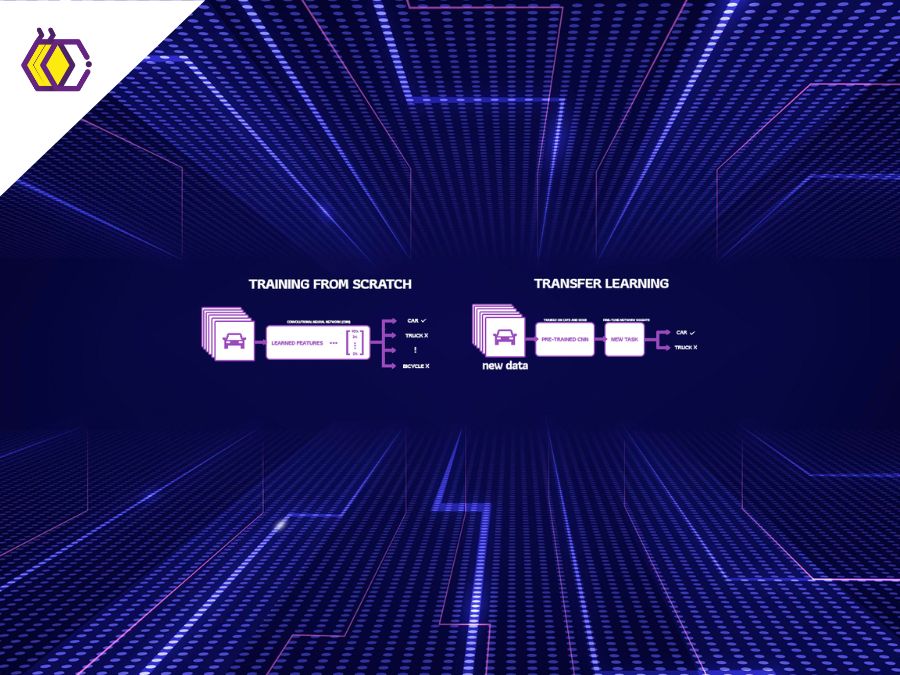

Transfer Learning
(8 minutes of reading) In the world of data science and deep learning, transfer learning has emerged as a powerful technique for boosting the performance and efficiency of machine learning models. Instead of starting from scratch, transfer learning allows you to take advantage of the knowledge acquired by models trained on large datasets and apply it to new specific tasks, speeding up the training process and improving model generalization. WHAT IS TRANSFER LEARNING? Transfer learning involves transferring learning from a pre-trained model to a new, related task. Instead of training a model from scratch, we start with a model already trained on a similar task and adapt it to this new task at hand. This is possible due to the ability of pre-trained models to learn general representations of data, which can be applied to different problems. BENEFITS OF TRANSFER LEARNING The main benefits of transfer learning are: Time and Resource Savings: Training models from scratch on large data sets can be computationally expensive and time-consuming. With transfer learning, you can reuse pre-trained models, saving time and valuable computing resources. Performance Improvement: Pre-trained models often capture general characteristics of the data, which can result in improved performance, especially when training data is limited for the new task. Improved Generalization: By starting with a model that has learned general data representations, we can avoid overfitting and improve the model's ability to generalize to new data, even across different domains. Flexibility and Adaptability: Transfer learning can be applied to a wide range of tasks and domains, making it a flexible and adaptable tool for different modeling needs. TRANSFER LEARNING IMPLEMENTATION When applying for transfer learning, it is important to consider some essential steps. Are they: Choosing Pre-Trained Model: Select a pre-trained model suitable for the new task based on its architecture and performance on similar tasks. When choosing the pre-trained model, it is crucial to consider the model's architecture and its performance on tasks like the one being addressed. For example, if you are working on an image classification task, models like ResNet , Inception , VGG , or EfficientNet may be suitable choices due to their proven architecture in various competitions and datasets. If the task involves natural language processing, models such as BERT, GPT or RoBERTa may be more appropriate due to their ability to handle complex text sequences and capture semantic relationships. When evaluating the performance of the pre-trained model, it is important to verify its accuracy, inference speed, and computational efficiency, ensuring it meets the specific needs of the new task and available resource constraints. Fine- Tuning or Feature Extraction: Decide whether you want to fine- tune the pre-trained model, adjusting its weights during training in the new task, or extract features from the model's intermediate layers to feed a new classifier. The decision between fine- tuning and feature extraction depends on the complexity of the new task, the size of the available data set and the similarity between the previous and current tasks. Fine- tuning involves adjusting the weights of the pre-trained model during training on the new task. This is suitable when the dataset is large, and the features learned by the pre-trained model are relevant to the new task. On the other hand, feature extraction involves freezing the weights of the pre-trained model and using the outputs from the intermediate layers as input to a new classifier. This is useful when the dataset is small, or the features learned by the pre-trained model are sufficient to represent the new task. In general, fine- tuning tends to provide better performance when sufficient data is available, while feature extraction is more appropriate for smaller data sets or when training the full model is computationally expensive. Model Adaptation: Customize the pre-trained model for the new task by tuning its architecture, adding specific layers, or tuning hyperparameters as needed. In the phase of adapting the pre-trained model to the new task, it is essential to customize the model according to the specific requirements of the problem at hand. This may involve several steps, such as adjusting the model architecture to meet the needs of the new task, adding specific layers to capture relevant information, and tuning the model's hyperparameters to optimize its performance. For example, if we are dealing with an image classification problem and the pre-trained model was originally trained for an object recognition task, we can adapt the model architecture, adding pooling, convolutional , or fully connected layers as needed. Additionally, we can tune the model's hyperparameters such as learning rate, batch size, and regularization to ensure the model is trained effectively and produces accurate results on the new task. This customization of the model is crucial to ensure that it can capture the specific nuances and complexities of the new task, resulting in optimal performance tailored to the needs of the problem at hand. Training and Evaluation: Train the adapted model with the new task data and evaluate its performance using appropriate metrics, adjusting it as necessary to achieve the best results. In the training and evaluation phase, it is essential to prepare data, tune hyperparameters, and monitor model performance. The data is divided into training, validation, and test sets, and the model is trained with the training data while we tune the hyperparameters to optimize its performance. Validation is performed to ensure that the model is not overfitting, and the final evaluation is done using the test data to calculate metrics such as precision, recall and F1-score. Final adjustments can be made based on the assessment results, and the entire process is documented and communicated clearly to all interested parties. This iterative approach ensures that the model meets the requirements of the new task and produces reliable, high-quality results. Transfer learning is a valuable technique for developers and data scientists, offering an efficient and effective way to develop machine learning models that perform better across a variety of tasks. By incorporating transfer learning into your development practices, you can save time, resources, and achieve more accurate and generalizable results. Therefore, explore the potential of transfer learning in your future modeling endeavors and enjoy its significant benefits.
Share this article on your social networks:
Rate this article:
[yasr_visitor_votes size=”medium”]



